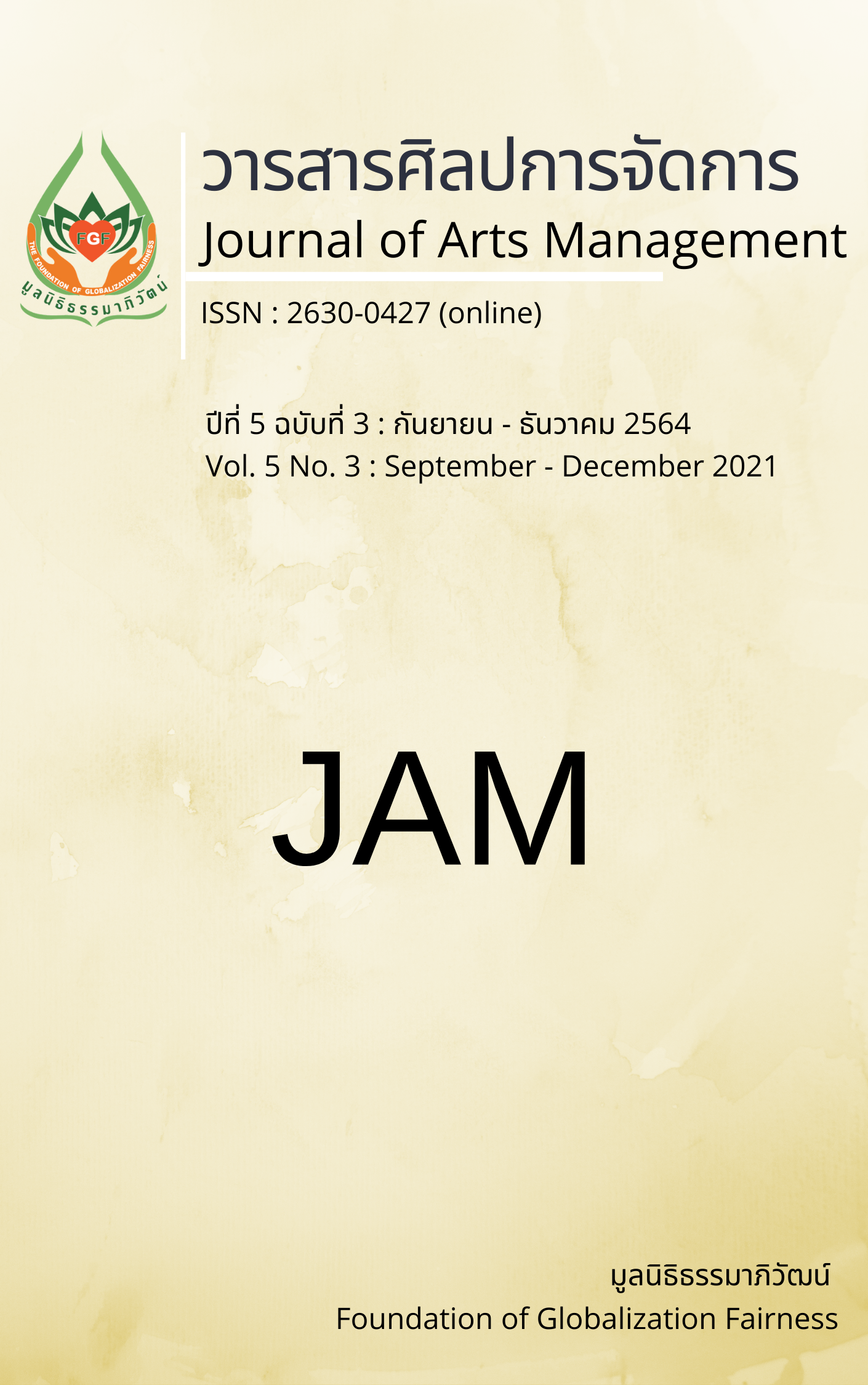The Acceptance of Risks from Purchasing Online Health Insurance in Bangkok after the Covid-19 Outbreak Situation
Main Article Content
Abstract
This article aimed to study factors influencing the acceptance of risks from purchasing online health insurance in Bangkok after the COVID-19 outbreak situation. The samples were 400 people in Bangkok who bought online health insurance. The data collection instrument was online questionnaires. The statistics used to analyze the data were mean, percentage, maximum, minimum, standard deviation, and path analysis.
The research results showed that the acceptance of risks from purchasing online health insurance in Bangkok consisted of 1) perceived usefulness, 2) perceived ease of use, 3) efficiency risk, 4) privacy risk, and 5) time risk. The model was congruent with the empirical data based on the statistical values of Chi-Square Probability = 0.07, Chi-Square Relative = 2.71, GFI = 1.00, RMSEA = 0.08. The model was fitted through the standard in all components. Also, the risk factors influencing the decision to purchase online health insurance are efficiency risk, time risk, and perceived ease of use at the highest level, followed by perceived usefulness at a high level, privacy risk at a moderate level, respectively. Health insurance business operators can use this research to plan strategies that are suitable and meet the needs of customers to purchase online health insurance and will develop the online service system in the future.
Article Details
Views and opinions appearing in articles in the Journal of Arts of Management It is the responsibility of the author of the article. and does not constitute the view and responsibility of the editorial team I agree that the article is copyright of the Arts and Management Journal.
References
Al-Jabri, I. M., & Sohail, M. S. (2012). Mobile banking adoption: Application of diffusion of innovation theory. Journal of Electronic Commerce Research, 13(4), 379-391.
Ayo, C. K., Mbarika, V. W., & Oni, A. A. (2015). The influence of trust and risk on intention to use e-democracy in Nigeria. Mediterranean Journal of Social Sciences, 6(S1), 477-486.
Banlang, S. (2021). The effect of service efficacy on the growth of 7-eleven convenient stores in the digital era. Journal of Arts Management, 5(2), 399-413.
Belynda, M. A., & Boaz, K. I. (2015). Factors influencing the adoption of mobile banking in kenya’s commercial banks: A case of Kenya commercial bank (KCB) Kilindini Branch. International Journal of Scientific and Research Publications, 5(10), 1-14.
Central Registration Office. (2021). Official statistics registration systems. Central Registration Office, Department of Provincial Administration Thailand. https://stat.bora.dopa.go.th/stat/consumer/Health_ins
Couto, J. P., Tiago, T., & Tiago, F. (2013). An analysis of Internet Banking in Portugal: The antecedents of mobile banking adoption. International Journal of Advanced Computer Science and Applications, 4(10), 117-123.
Crawford, M., & Di Benedetto, C.A. (2011). New Products Management. McGraw Hill Irwin.
Davis, F. D. (1989). Perceived usefulness, perceived ease of use, and user acceptance of information technology. Management Information Systems Research Center, University of Minnesota, 13(3), 319-340.
DeLone, W. H., & McLean, E. R. (2003). The DeLone and McLean model of information systems success: A ten-year update. Journal of Management Information Systems, 19(4), 9-30.
Donladpun, C., & Zumitzavan, V. (2020). Customer’ decision-making in purchasing online-goods: A case study of Khon Kaen municipality. Journal of Social Science, 5(6), 118-131.
Hair, J., Black, W., Babin, B., Anderson, R., & Tatham, R. (2006). Multivariate data analysis (6th ed.). Pearson Prentice Hall.
Lin, J., Xiao, S., & Cao, Y. (2010). Predicting and explaining the adoption of mobile banking. Proceedings of Annual Conference of China Institute of Communications, 421-424.
Kaewchuer, S., Phungniran, B., & Kortana, T. (2019). Factors for success for online business entrepreneurs in the digital age. The Journal of Industrial Technology, 15(2), 33-44.
Kanlyanamitra, K. (2021). Management strategy implementation in a new normal model. Journal of Social Science and Buddhistic Anthropology, 6(4), 402-422.
Kristi, K. M., & Kusumawati, N. (2021). Technology acceptance and customer perception of augmented reality (AR) in Indonesian beauty industry. Proceedings of the 3rd International Conference on Economics, Business and Economic Education Science. http://dx.doi.org/10.4108/eai.22-7-2020.2307916
Liu, X., & Wei, K. K. (2003). An empirical study of product differences in consumers’ E-commerce adoption behavior. Electronic Commerce Research and Applications, 2(3), 229-239.
Luamcharoen, P. (2018). Health Insurance. Public Health & Health Laws Journal, 4(1), 75-87.
McKechnie, S., Winklhofer, H., & Ennew, C. (2006). Applying the technology acceptance model to the online retailing of financial services. International Journal of Retail & Distribution Management, 34(4/5), 388-410.
Pankham, S., & Kongkuthong, R. (2021). The Influencing of causal factors repurchasing intention cosmetics on facebook fanpage of consumers in Bangkok and its vicinity. Journal of Arts Management, 5(2), 272-285.
Phuthong, T., & Mangsungnoen, N. (2017). Factors influencing the elderly intention to use and adopt mobile health services. Veridian E-Journal, Silpakorn University, 10(2), 548-566.
Rogers, E. M. (2003). Diffusion of innovation. (5th ed). The Free Press.
Slade, E. L., Dwivedi, Y. K., Piercy, N. C., & Williams, M. D. (2015). Modeling consumers’ adoption intentions of remote mobile payments in the United Kingdom: Extending UTAUT with innovativeness, risk, and trust. Psychology & Marketing, 32(8), 860-873.
Suksawang, P. (2014). The basics of structural equation modeling. Princess of Naradhiwas University Journal, 6(2), 136– 145.
Suwannik, S. (n.d). How will the world change? After the Covid-19 crisis is over?. Bank of Thailand. https://www.bot.or.th/Thai/ResearchAndPublications/articles/Pages/Article_30Mar2020.aspx
Yamane, T. (1976). Statistics: An introductory analysis. (2nd ed.). Harper and Row.


